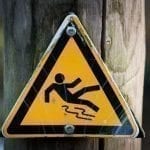Recognizing and Mitigating Winter Hazards on the Job Site
Whether you’re ready or not, winter is here and in full effect. And while most of us really enjoy getting into the holiday spirit, we’re not quite as enthusiastic about the plunging temperatures, snowy roads, and icy sidewalks.
Not only are these weather developments a nuisance in our personal lives, they can also create severe work hazards, which could result in serious personal injury to you, your loved ones, and your coworkers. Fortunately, you can avoid injury from these types of hazards if you pay attention to some of the following safety tips.
Employer Responsibility
The first step toward remaining safe when working outdoors in winter is to recognize the potential risks and hazards inherent in your line of work. This begins with your employers encouraging and enforcing safe work practices. According to the Occupational Health and Safety Administration (OSHA), these practices include:
- Providing workers with the proper tools and equipment to do their jobs safely
- Developing work plans that identify potential hazards and corresponding safety measures that will protect workers
- Scheduling jobs that expose workers to the cold weather during the warmest part of the day
- Avoiding exposure to extremely cold temperatures when possible
- Limiting the amount of time spent outdoors on very cold days
- Providing warm areas for use during break periods in cold weather as well as warm beverages to prevent dehydration
- Having a reliable means of communicating with workers and being able to stop work or evacuate when necessary
Proper Winter Attire
The employer responsibilities above represent a great starting point when it comes to worker safety, but employees also need to take personal responsibility for their health and safety during the winter months, especially when it comes to avoiding hypothermia.
Hypothermia is the result of the body losing heat faster than it can replace it. Hypothermia sets in when the body’s internal temperature dropping below 95⁰ F (compared to a normal temperature of 98.6⁰ F), which can lead to serious health complications and even death.
Three of the primary risk factors that tend to contribute to hypothermia are:
- Wetness
- Exhaustion
- Improper clothing
In addition, certain medical conditions (hypertension, diabetes, etc.) and poor physical conditioning make people more likely to develop hypothermia.
By avoiding the third risk factor listed above — that is, wearing improper clothing — you can significantly lower your overall risk for hypothermia. To begin with, all employees working outdoors during harsh winter weather should wear extra layers of clothing; however, make sure that the sizes are large enough so as to not restrict blood flow, and neither so large nor small as to impede your ability to do your job safety and comfortably. (This can help prevent exhaustion, too, as more flexibility lessens the effort required to perform tasks.)
While wearing layers is advisable, you should also be prepared to shed one or two of those heavy layers if you begin to overheat and/or sweat, as dampness can increase the rate of heat loss and lead to hypothermia.
Lastly, you should also wear insulated, waterproof boots that fit properly and provide a great deal of traction for slippery surfaces, especially if you are working in an elevated setting.
Workplace Hazards
In addition to following your employer’s health and safety recommendations and dressing appropriately when working in the cold, there are also individual hazards that you might be exposed to depending on the nature of your work. These can include:
-
Winter Driving:
The slippery conditions inherent in winter driving mean that you need to drive slowly, maintain more distance than usual between vehicles, be on the lookout for pedestrians when visibility is limited, and never drive under the influence of drugs or alcohol. In addition to taking the proper precautions while driving, you should always make sure to properly inspect your work vehicle regularly (paying close attention to the battery, tire tread, and brakes) and also carry an emergency kit within the vehicle at all times.
-
Traffic Zone Safety:
If you’re working in a traffic zone, there’s a reasonable possibility of accidents, injuries, or even fatalities. Therefore, you should always wear highly visible clothing as required by OSHA and work within zones that have been properly cordoned off with cones, barrels, and other barriers. Drivers are prone to skidding and losing control of their vehicles in the snow and ice, so be sure to remain aware of your surroundings at all times.
-
Using Powered Equipment:
When using powered equipment such as a snow blower, be sure that the machinery is grounded to protect from electrocution. Additionally, make sure that any powered equipment is disconnected and properly guarded before undertaking maintenance or cleaning. Severe lacerations or even amputation can result from workers attempting to fix, clean, or unjam a machine that is still in operation or connected to a power source. Lastly, always refuel machines prior to use; never add fuel while the equipment is still running or the engine is still hot.
-
Working Above Ground:
When working above ground, you should be aware of ice layers – both exposed and under the snow. Mark these areas appropriately and add salt or de-icer to melt the ice more quickly. Once the ice is melted, you can shovel away the access using proper lifting techniques. You should also be sure that a designated and qualified individual is able to determine the structural safety of any heightened surface that is being weighed down by heavy snow and ice. This person should also be able to determine any potential fall zones that might be obstructed by the snow.
-
Preventing Slips, Trips, and Falls:
Falls resulting from slippery workplace surfaces are among the most common types of workers’ compensation injuries we see every winter. To lower your risk for these injuries, always remain aware of your surroundings. Avoid and tape off any areas that appear especially slippery, and wear the proper footwear ― insulated, waterproof boots with high-quality rubber threads. If your occupation does not require you to wear rubber boots regularly, you should keep a pair of rubber over-shoes in your vehicle during winter. Try to walk more slowly and take shorter steps whenever walking on icy or snowy surfaces.
Contact the Law Offices of George A. Malliaros If You’ve Been Injured on the Job
We hope that you remain safe and healthy this winter, but if you’re injured at work or suffer a work-related illness this winter, you may be able to make a financial recovery for your losses by filing a workers’ compensation claim. The Law Offices of George A. Malliaros has extensive experience dealing with workplace injuries, and we can discuss your injury and the circumstances surrounding it during a free consultation.
To schedule your free consultation, please call us at (978) 452-6641 or complete the convenient online form on this page. If you’re concerned about payment, we handle cases on a contingent fee basis, which means that you will not pay fees or expenses unless or until we are able to achieve a recovery on your behalf. Please don’t delay, though, as the statute of limitation for filing a personal injury claim in Massachusetts is only three years from the date of the incident.
References:
Cold Stress Guide. (n.d.). Occupation Health and Safety and Administration. United States Department of Labor. Retrieved from https://www.osha.gov/SLTC/emergencypreparedness/guides/cold.html
Hazards/Precautions. (n.d.). Occupational Health and Safety and Administration. United States Department of Labor. Retrieved from
https://www.osha.gov/dts/weather/winter_weather/hazards_precautions.html





